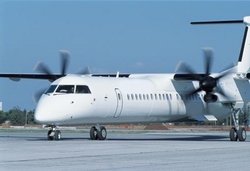DH-8-100 Propeller Control Unit Involved In An Inadvertent Feather Event
On July 25, 2013, an inadvertent feather event occurred shortly after takeoff on a DeHavilland DHC-8-100 series aircraft. Flight data records indicated that the #1 PCU beta switch was closed and lit during takeoff when a beta condition did not exist. During this event, the switch remained closed as the propeller transitioned above the ground handling range during takeoff. This condition resulted in a propeller over-torque when the aircraft’s beta backup system became active and commanded the propeller to feather while the engine was in a high-power condition.

Examination of the subject PCU revealed that the beta light assembly was installed incorrectly, deforming the switch case. A deformed switch case can adversely affect switch function reliability and cause the switch mechanism to malfunction. The malfunction could manifest as a failed closed switch or by an intermittent delayed opening of the switch.
The FAA has released a Safety Alert For Operators (SAFO) advising airplane owners/operators about the potential for un-commanded feathering events when PCUs and adapters are improperly installed, repaired or overhauled.
The basic PCU is widely used by UTC Aerospace (Hamilton Sundstrand/Hamilton Standard). Because there may be variations for different aircraft and propeller models, owner/operators should verify specific components installed on their aircraft or in inventory. The list of propellers and aircraft that use PCUs include (but are not limited to): Hamilton Standard Models 14RF-9, 14RF-19, 14RF-21, and 14RF-23; 247F-1; 14SF-5, 14SF-7, 14SF-11, 14SFL11, 14SF-15, 14SF-17, 14SF-19, 14SF-23; and 6/5500/F propellers installed on Embraer EMB-120 and EMB-120RT; SAAB-SCANIA SF340B; Aerospatiale ATR42-100, ATR42-300, ATR42-320, ATR72, ATR72-210; DeHavilland DHC-8-100, DHC-8-200, and DHC-8-300 series; Construcciones Aeronauticas SA (CASA) CN-235 and CN-235-100; Canadair CL215T and CL415; and British Aerospace ATP airplanes. These airplanes are all twin engine installations.
Hamilton Sunstrand Corporation issued Service Bulletin 14SF-61-148 in June of 2001 to address and limit intermittent switch failure on 14SF PCUs.
Pacific Propeller International (PPI), LLC had performed maintenance on the PCU installed on the DeHavilland DHC-8-100 series aircraft that experienced an inadvertent feather event on takeoff. PPI subsequently identified an error in the assembly of the beta switch and the mounting spacers. It was determined that technicians assembled the switch with parts identified in Service Bulletin 14SF-61-148 while using the instructions that were in the Original Equipment Manufacturers (OEM) Component Maintenance Manual (CMM) instead of following maintenance instructions as defined in Service Bulletin 14SF-61-148. This error resulted in beta switch damage. PPI also determined that this error may also affect additional units of 14SF PCU’s repaired/overhauled between June 4, 2001 to September 26, 2013. PPI has notified the owner/operators of affected units overhauled/repaired between July 12, 2003 to September 26, 2013. PPI is unable to identify customers who may have had units repaired/overhauled between
June 4, 2001 and July 11, 2003.
The SAFO recommends that owners and operators of propellers and aircraft listed above should be familiar with the content of this SAFO and should ensure that any affected PCU’s are removed and replaced as soon as possible; beginning with those twin-engine aircraft where affected units are installed on both engines.
 Aero-News: Quote of the Day (04.28.25)
Aero-News: Quote of the Day (04.28.25) ANN's Daily Aero-Term (04.28.25): Decision Altitude (DA)
ANN's Daily Aero-Term (04.28.25): Decision Altitude (DA) ANN's Daily Aero-Linx (04.28.25)
ANN's Daily Aero-Linx (04.28.25) Airborne-Flight Training 04.24.25: GA Refocused, Seminole/Epic, WestJet v TFWP
Airborne-Flight Training 04.24.25: GA Refocused, Seminole/Epic, WestJet v TFWP Aero-News: Quote of the Day (04.29.25)
Aero-News: Quote of the Day (04.29.25)



